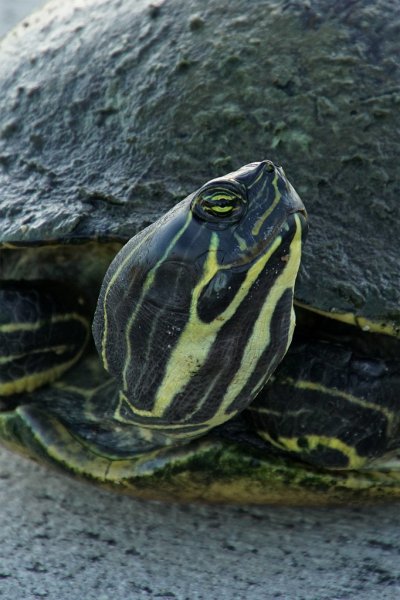ANIMAL: River Cooter Pseudemys concinna Type of Animal: Turtle Habitat: Freshwater & brackish rivers/lakes/ponds/marshes/streams/oxbow lakes/reservoirs/impoundments/tidal marshes/swamps/ditches w/ slow/moderate/fast current, heavy vegetation, clear water, & rocky bottoms, peninsular floodplains associated w/ river oxbows, saltwater areas near river mouths, floodplain river pools, deep springs, sloughs, backwaters, prefers shallower areas in habitat Location(s): Found from Virginia S to mid-Georgia, west to E Texas, Oklahoma, and north to S Indiana Appearance: Eastern subspecies has dark greenish-brown carapace (upper shell) w/ C marking facing posterior, yellow markings sometimes present, reddish-brown background color, yellow to reddish-orange plastron (bottom shell) w/ dark pattern between scutes, Florida subspecies less yellow markings, Suwannee subspecies black carapace w/ yellow markings, light orange/yellow plastron w/ black markings, females larger than males w/ smaller tails/more convex plastrons, hatchlings/juveniles green round carapace w/ bright yellow markings. Food/Diet: Algae, aquatic plants, turtle grass, leaves, fibrous vegetation, snails, crayfish, insects, tadpoles, small fish, carrion, worms, vegetables Status in Wild: Stable Conservation: Breeding in zoos & aquariums. Restrictions on sale of turtle eggs and young turtles. Lifestyle: Found in groups of 4-10 turtles Additional Info: Called: Male Female Young-Hatchling Group-Bale Weight: Male-5 lbs Female-7 lbs Young-0.5 oz Gestation: 3 months Life Span: 30-40 years Body Length: Male-9-10 in Female-12 in Young-1.5 in Tail Length: Male-2 in Female-1 in Main predators of adults are crocodilians, snakes, raptors, foxes, bobcats, otters, & raccoons. Crows eat young & occasionally, small males. Muskrats, opossums, herons, & bullfrogs prey on young. Temperature determines sex of eggs, males at lower temps & females at higher temps. Males sexually mature at 6 years old, females at 13 years. Nesting season occurs in May & June Females produce 2-6 clutches a year, w/ 3-20 eggs per clutch. Often pile on top of each other when basking. They’re active during the day (diurnal). Prefer to be hidden in aquatic plants during winter dormancy or sleeping each night. Females nest in area w/ sandy or loamy soil. Fun Fact(s): Name “cooter” may derive from African word “kuta” meaning “turtle” in Bambara & Malinke languages. Very difficult to capture due to skittishness. They’ve been known to walk long distances over land to reach new water sources.

